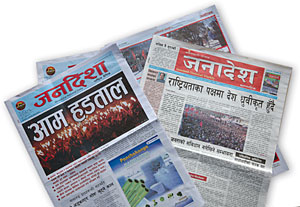 |
The Maoists have once again shown they are masters of media manipulation. Just as it appeared that they were on the verge of going off the publicity radar, they have managed to hog the headlines and monopolise primetime.
Ever since their scuffle with UML in the mid-nineties for the control of a blank wall to paint party slogans near Ratna Park, the Maoists have dominated media coverage. The favourable press that the most violent political group in Nepal's modern history continues to get is a mystery worthy of exploration by media studies scholars.
When they began their violent campaign in the mid-mountains, the Maoists had little access to the mainstream media. The commentariat in Kathmandu bristled with UML-types who would jump at any chance to attack the NC. The idea of Nepali nationalism was still based on kneejerk anti-Indian rhetoric. The Maoist media strategy took advantage of these absurdities of the popular press.
The Narayanhiti Massacre provided the Maoists with an opening to run their disinformation campaign. The press, including the most popular Nepali daily of the time, became their mouthpieces. With the escalation of armed conflict, the Maoists forced the media to do their bidding. Those that dared to hold independent views were threatened, attacked or killed, as the case of Dekendra Thapa of Dailekh illustrates.
When Maoist leaders were forced to take shelter in India, they had to come up with a strategy to deflect attention from their dependence on that country. So they directed their cadres to begin digging trenches on the Nepali side of no-man's land. In a country where the middle class has turned a besieged mentality into a nationalistic virtue, this turned out to be a failsafe strategy to promote the agenda of armed insurgency.
The response of the mainstream parties to the propaganda onslaughts of the Maoists was often incoherent, limp and self-defeating. Commentators close to NC claimed that Maoist guerrillas were merely UML cadres in mufti. UML footsoldiers in the media responded that the guerrillas were maiming and killing only class enemies. Former Panchas in rightwing parties were happy that communist guerrillas had declared them nationalists. In this confusion, all that Chairman Prachanda had to do was spread the rumour that Pushpa Kamal Dahal did not exist, and the media left him free to travel between New Delhi and Lucknow.
The only time the Maoists' disinformation machinery faltered was when they joined the coalition government. It did not get any better when Dahal led the ruling alliance and tried to strengthen his hold over state institutions.
When Dahal had to resign under duress, his propagandists realised the Maoists would now be targeted by the mainstream media. Resistance would have been pointless and even counterproductive. So they decided to play along and be as spectacular a target as possible.
Journalists have since discovered that we can love them or hate them, but we cannot ignore the Maoists. It seems the moment Dahal is removed from the headlines, there is nothing to report on. The wily supremo uses his indispensability to make the media magnify the Maoists' conceited posturing. To pander to the prejudices of hypernationalists in UML and the fronts of former Panchas, all one needs to do is call for the revision of the Nepal-India Treaty of 1950 and vociferously oppose 'expansionist' encroachments at Susta and Maheshpur. In fact, Dahal probably overdid his 'dialogue with masters' rhetoric.
More useful has been the reported rift between Dahal and his alter ego Baburam Bhattarai. No matter whose side the media takes, the Maoists reap the publicity benefit.
The best way to counter Maoist propaganda is to deny them the oxygen of publicity. Even when Dahal's buffoonery is ridiculed in print, he still emerges a winner in front of his core constituency - the masses in the countryside that deeply resent the holier-than-thou attitude of the urban middle class. In the art of deception, the Maoists have proved that they have no equals in Nepal.



